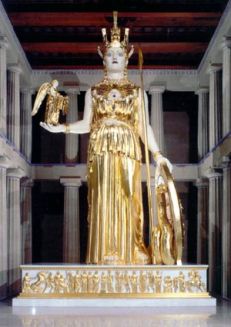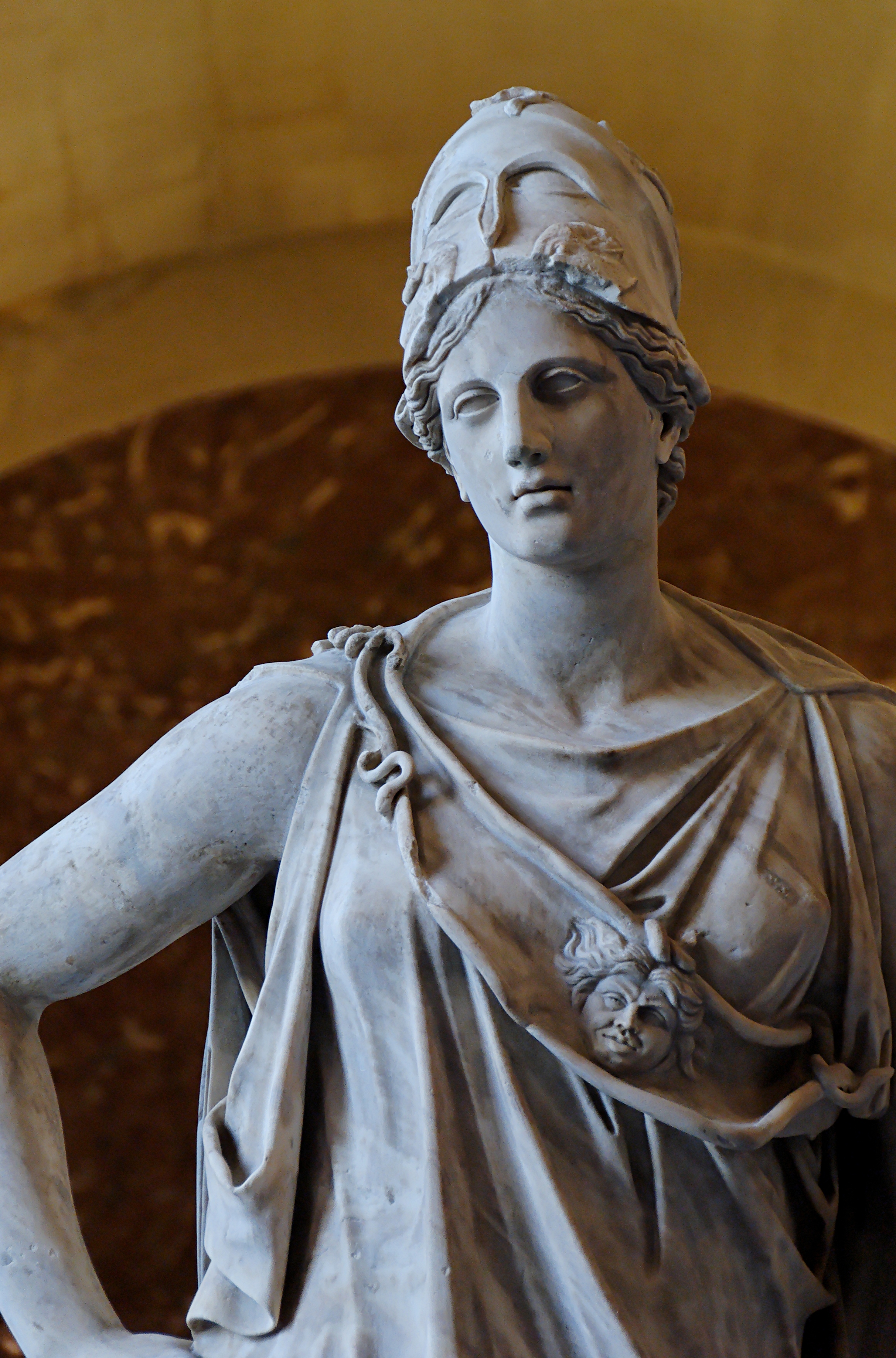Notes from the Studio: Wise Athena
December 11, 2016

Adolf Furtwängle, Lemnia Athena (reconstruction)
Marble, 1891
Staatliche Museum, Albertinum, Dresden, Germany
Note: A version of this post originally appeared on the blog Venetian Red.
For the past several months Athena, the Greek goddess of war, civilization, wisdom, strength, strategy, crafts, justice and skill (a versatile goddess if ever there was one) has been much on my mind. In fact, she’s become the central energy source of a commissioned piece I am now completing, a digital montage which owes its technical inspiration to the work of Hannah Höch. I’m hoping Athena will stick around even after our work together is completed; I’d be grateful if a bit of her majesty, grace, and wisdom would rub off on me.
Although best known as a Greek goddess, the cult of Athena predates the ancient Greeks. Perhaps she was brought to Greece from Egypt in the 2nd millennium BCE. Classicist Robert Graves tags the “birth” of the Athena myths to Crete as early as 4,000 BC. Nevertheless, the Greeks embraced her wholeheartedly; as early as the 7th c. BCE she had become a central player in the pantheon of the Gods and patron of city of Athens. On the Acropolis, besides the Parthenon, she has two other temples—the temple of Athena Nike and the Erechtheum. The epithet Pallas frequently added to her title derives either from the Greek “to strike” or (more probably) from the Greek “girl.”

Athena Parthenos (replica)
Marble
Throughout antiquity Athena (Hellenizing Romans turned her into Minerva) assumed many sculptural guises; undoubtedly the most famous of which is the Athena Parthenos, a massive ivory and gold statue (36 meters high) located on the Acropolis from the 5th century BCE to the 5th centure CE. The sculptor Pheidias set the Athena standard—in adition to the Parthenos, he also crafted a reputedly even-greater bronze statue, made out of the spoils taken by the Athenians in the battle of Marathon and a small bronze statue called the “beautiful” or the Lemnian Athena, as it originally was dedicated in Athens by the Lemnians.
Helmeted Athena is the most common rendering of the goddess, likely to personify her mythic origins. Traditional stories recount that Zeus was warned by Gaia and Uranus that his children by first wife Metis would be dangerously clever. Fearing that Metis would bear a son mightier than himself, Zeus swallowed her. No doubt envisioning the power her daughter might possess, Metis immediately began to fashion a robe and helmet for her. The hammering of the helmet caused Zeus such great pain that he called out for his skilled son Hephaestus to split open his scull with an axe. As a result, Athena emerged, fully grown and wearing her mother’s robe and helmet. Eternally a virgin deity, Athena never took a lover or consort.

Athena Pella Museum, Greece
Athena is an unusual goddess, as female deities are rarely depicted in full armor. Armored Athena wears any of a number of different types of helmets—the gorgeously-shaped Corinthian with its distinctive bubble; a Roman-type galea with plumage; and sometimes just a small cap-like covering. Traditionally, Athena’s shield and aegis (collar/belt) bear the face of the gorgon Medusa. Medusa serves a double purpose—as a reminder of Athena’s involvement with Perseus’ defeat of the famous monster and as device in battle with which to transfix her enemies with fear (Medusa is reputed to have turned men to stone as they looked on her). For followers of Athena, inclusion of the Medusa iconography would have served as a reminder to visiting foreigners of the military power of the city.
Armored Athena is usually depicted with an extended right arm supporting a small representation of Nike, the Goddess of Victory, in the palm of her hand. Often she is also accompanied by the snake Erichthonius, whom she adopted. The first virgin mother?
Sculpted versions of the armored Athena perfectly portray the androgyny of the goddess, who traditionally embodies both feminine and masculine attributes. Although girded for war, Athena disliked fighting without a purpose, preferring to use wisdom to settle disputes.
Athena, strong and sensible woman. The shrewd companion of heroes (Odysseus, for one). The goddess of heroic feats. Patron saint of the “useful and elegant” arts—weaving, pottery and music at any rate.
Ongoing visitor to my studio, please.
Beyond This Post
Robert Graves—The Greek Myths: Complete Edition
Sheila Dillon—The Female Portrait Statue in the Greek World
The many faces of Athena
Save







What a lovely and relevant post. ‘m talking a class on Ancient and we are reading our way through the dramatists, Plato and the poets. I’m also reading Mary Renault on the side. I think that it’s a pity that our educational system now often neglects these classics, including the art of this period. We have become blase about it, which is a shame. The beauty, grace and power have impressed the West for over 2000 years and there was a reason for it. Looking at those gorgeous and serene faces gives us a small taste of what it must have been like to have seen them for the first time.
Homeric Hymn to Athena: I begin to sing of Pallas Athene, the glorious goddess, bright-eyed, inventive, unbending of heart, pure virgin, saviour of cities, courageous, Tritogeneia. From his awful head wise Zeus himself bare her arrayed in warlike arms of flashing gold, and awe seized all the gods as they gazed.
Great post and photos – love the many representations of Athena.
Lovely post.
Wish we all had an equally powerful, beautiful image of female power and intelligence before our eyes every day — instead of mindless “celebs”.
Caitlin
Amen to that sentiment. Put them into a ring; I’m betting Goddess Athena would knock the Lady Gaga!
cool!
i love athena now, its railly interessant
Thanks for your blog and the many images and links about Athena. Now I have to chase the Lemnos / Lemnian connections and Athena. I have been working on The Birth of Athena as subject for a while and just started a series of Argonautica print images that include Goddess Athena and her influence in the Jason, as Hero, Journey.